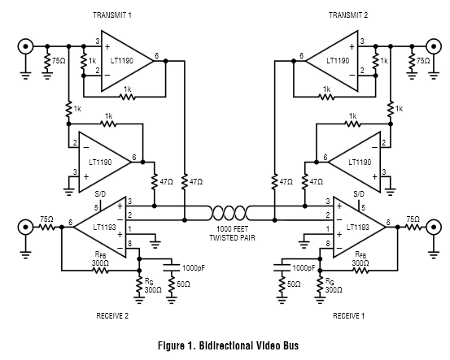I have written about passive methods on adapting 75 ohm video signals to 100 ohms UTP wiring at Differential video signals on UTP cable section of ePanorama.net and my postings Audio, Video and other signals over UTP, Video over UTP and Video over UTP – commercial balun circuit articles. Possibility to send composite video signals appreciable distances on a low cost twisted-pair wiring saves money: standard 75W RG-59/U coaxial cable costs between 25¢ and 50¢ per foot, but a PVC twisted-pair is only pennies per foot). Active circuits typically allow longer distances than passive circuit. Now it is time to tell how active circuits work.
Color video travels on twisted-pair cable article has this circuit diagram of a quite typical video to UTP adaptation:
The circuit design is quite simple to understand. The system consists of two circuits. The first converts the composite video signal to a differential signal using amplifiers IC1 and IC2. On the receiving end there is one fast operational amplifier IC3 wired to work as a differential amplifier. The circuit has a minimum signal gain of two to compensate for the terminations’ 6-dB signal drop.
This circuit treats the twisted-pair cable as a transmission line that is back-terminated with 75 ohm resistors. The termination method gives 150 ohm output impedance between the wire pair, that is somewhat between the traditional low frequency 600 ohm characteristic impedance and high frequency 100-120 ohm impedance of telephone wire pair.
There are also other circuit examples. Send Color Video 1000 Feet Over Low Cost Twisted-Pair application note shows how video over UTP adapters can be made using LT1190 Op Amp as transmitter and the LT1193 Video Difference Amplifier as receiving end. The circuit example shows a bidirectional implementation where video could be sent to either direction as needed.
The circuit topology for transmitter side is pretty similar in idea to the first circuit, just different amplifiers and somewhat different other component values. This transmitter circuit uses 47 ohms + 47 ohms termination on the transmitting and receiving end, meaning around 100 ohms differential impedance termination for the twisted pair wire.
The receiver side uses special differential input amplifier IC LT1193. This circuit has also option to provide cable compensation at the amplifier’s feedback node. In this case, 1000 feet of twisted-pair is compensated with 1000pF and 50 ohm to boost the –3dB bandwidth of the system from 750kHz to 4MHz.
When distances get longer than few hundred meters, you will really start to need some kind of equalization to keep signal quality good (like it is needed on coaxial cable as well). There are also special ICs designed for this.
Adaptive Equalizer for Video Over Twisted Pair page tells that MAX7474 adaptive equalizer recovers losses incurred in the transmission of a composite video (CVBS) signal over unshielded twisted-pair (UTP) cable. The device fully recovers losses for cable lengths of up to 300m and greatly improves signal quality for cable lengths of up to 600m. The device automatically adapts to all cable lengths for CVBS signals with color burst and allows fixed-equalization settings for video signals without burst.
Equalizer IC receives video over one mile of Category 5 cable article describes a special IC designed for long distance cable compensation. ISL59605 MegaQ video-equalizer IC compensates for high-frequency cable loss as high as 60 dB at 5 MHz and source-amplitude variations. The unit continuously monitors the cable characteristics and tries to compensate them.


4 Comments
Tomi Engdahl says:
Increasing cable length in precision video applications
http://hackaday.com/2015/12/04/increasing-cable-length-in-precision-video-applications/
Transmitting video signals over long distances can be tricky. Cheap co-ax cables won’t do the job. You either need amplifiers along the path, or need to use expensive, high quality shielded co-ax cables – both of which can end up costing a lot. [Maurizio] built a low cost solution to transmit video over long distances using twisted pair cables.
The system is cheap and uses readily available parts. The idea is to convert the video signal into a differential output using a pair of op amps and transmit them over a pair of twisted pair wires, then extract the signal at the receiving end using another amplifier.
This symmetrical configuration renders the system immune to external noise. The design was tested for transmitting video on inexpensive CAT-3 twisted pair wire. According to him, when transmitting on 300m of wire, good quality color video was displayed on a monitor with an NTSC input. He used LMH6643 op-amps for this experiment, but other devices with similar characteristics can be used.
http://dev.emcelettronica.com/increasing-cable-length-in-precision-video-applications
Tomi Engdahl says:
Here’s a useful PDF document that discusses signals, cables and connections.
http://www.kramerelectronics.com/downloads/manuals/cable.pdf
Tomi Engdahl says:
http://www.savel.org/2007/10/26/video-over-utp/
https://electronics.stackexchange.com/questions/331050/clamper-for-easy-dc-restore-in-video-composite
Tomi Engdahl says:
Twisted-Pair Transmission of Closed-Circuit Video Made Easy
https://www.analog.com/en/technical-articles/twisted-pair-transmission-of-closed-circuit-video-made-easy.html
With the pervasive adoption of twisted pair infrastructure for in-building communications, developers of closed-circuit television (CCTV) systems face increasing pressure to utilize this popular medium. Twisted-pair cabling (Category V, commonly known as CAT5, being the prevalent example) offers the end user many more signals per cable pulled and reduced termination costs compared to traditional coaxial-cable (coax) solutions.
The technical drawback to twisted-pair transmission, especially with commonly used unshielded-twisted-pair (UTP), is the tendency for common-mode noise pickup to degrade the video quality at the receive end amplifier. This receiver issue is effectively eliminated by using the LT6552 differential-input amplifier, due to the very high common-mode rejection-ratio (CMRR) of the part at high frequencies. The LT6552 also provides cable-driving output capability, thereby simplifying both the conversion of camera coax signals into twisted-pair transmissions and twisted-pair signals back to coaxial.